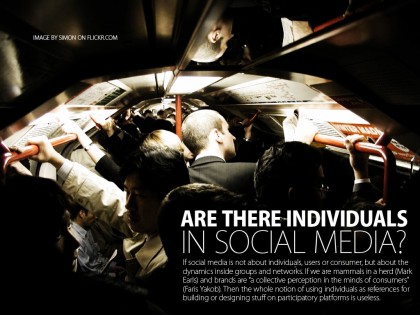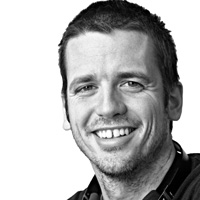Inspired by a question posed by @gabyrosario on Twitter I found myself thinking that if social media is not about individuals, users or consumer, but about the dynamics inside groups and networks
Prevalence and Association with Age How long does sildenafil last? high (26) . The side effects associated with injection therapy.
. If we are mammals in a herd (Mark Earls) and brands are “a collective perception in the minds of consumers” (Faris Yakob)
. Then the whole notion of using individuals as references for building or designing stuff on participatory platforms is useless.
If the goal of social media activities is to sow or game the dynamics of the collective, then we need to get better at understanding group dynamics rather than individual motivations
.
Why do we still talk about individuals when it comes to Social media?



Very interesting question which I think touches on another conceptualization yet to be made in this post-digital era in order for us to fully understand how to nurture the potential of social media.
However we should be careful not to revert to a simple dualism by contrasting individuals to networks, as good and bad sides. Is it not the essence of the network to consist of individuals? Is it not the essense of individuals in order to be individuals to be part of a group? It is a question of method: the individual should be put back in the network. This operation is not at all symmetrical (which obviously is your point), for it is inaccurate to say that a group of individuals reproduces the network. It is instead like a photograph or X-ray that begins by selecting or isolating what it intends to reproduce. If we continue to look at networks from the perspective of individuals then we generate and structuralize the network in a way that’s actually only reproducing the individuals perspective of the network itself. That’s why your question is so relevant.
The french philospher Gilles Deleuze has invented an interesting idea called ‘the rhizome’ which he opposes to an idea of ‘the tree’. The tree consists of tracing, on the basis of an overcoding structure or supporting axis, something that comes ready-made. The tree articulates and hierarchizes tracings; tracings are like the leaves of a tree.
The rhizome is altogether different, it’s a map and not a tracing. What distinguishes the map from the tracing is that it is entirely oriented towards experimentation in contact with the real. The map fosters connections between fields, the removal of blockages, it is itself a part of the rhizome. The map is open and connectable in all it’s dimensions; it is detachable, reversible, susceptible to constant modification. It can be torn, reversed, adapted to any kind of mounting, reworked by an individual, group, or social formation. Perhaps one of the most important characteristics of the map is that it always has multiple entryways as opposed to the tracing, which always come back to ‘the same’.
That is why it is so important to try the other, reverse but non-symmetrical, operation. Plug the tracings back into the map, connect the roots or trees back up with a rhizome. In other words “the whole notion of using individuals as references for building or designing stuff on participatory platforms is useless”.
Then of course the difficult part is to translate this into how to actually construct infrastructures to facilitate group dynamics and establish participatory platforms. How to establish and build the architecture around it – but that is another not less difficult discussion we’ll have to solve in order to succeed with social media in the time of post-digitalism.
Hi Bo
Yet again a superb enrichment of the initial question. :o)
The rhizome is very interesting, I haven’t heard of the idea before, but will make sure to check it out.
As you’ve brilliantly picked up on, the post is a challenge: If we talk about networks and groups all the time, then we need to start looking at group dynamics more, not individual motivations. The latter is much easier to discuss as it is by far more familiar, but it is not as useful.
I find a lot of the stuff by Mark Earls very interesting and will hopefully be able to share some ideas around his terminology and ideas in the near future..
Thanks again for contributing.
Best
Helge
Seems like the topic of the moment here, interesting stuff. Feels funny really that ultimately marketing is coming full circle from street vendors peddling their wares around cities and towns, to mass media and back again. Only now the streets are replaced with web sites and the crowds chattering amongst themselves sharing opinion and influence now do so through different devices.
I’m certainly impressed with Mark Earl’s surfacing of this thinking, but it’s principles are well documented in history through Edward Bernays founding ‘Public Relations’ based on his Uncle Freud’s perspectives of controlling group behaviour.
There’s an interesting American guy in London who’s worked in politics and marketing via his company http://www.cultdyn.co.uk/
Be pleased to have a chat about this sometime.
Best wishes
Clyde